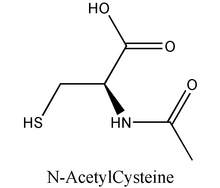Mucomyst
N-acetylcysteine is a chemical, commonly called NAC, produced by the body that enhances the production of the molecule glutathione, a powerful antioxidant. NAC is a thiol, in which the hydrogen atom can act to reduce free radicals. more...
In the United States, NAC is available as an over the counter supplement in health stores and in a prescription-only oral solution as Mucomyst® (Bristol-Myers Squibb) or Mucosil® that can be ingested or aerosolized and inhaled. Outside of the United States, it is available in pharmacies as an over the counter oral medicine and also available in an intravenous form as Parvolex®.
Clinical uses
NAC has different uses in the treatment of medical conditions:
- Treatment of acetaminophen (paracetamol) overdose. When NAC is administered either intravenously or orally, it protects the liver from damage caused by toxic metabolites that exhaust glutathione stores.
- Mucolytic. NAC is used as a mucolytic ("mucus dissolving") agent to help break up the thick mucus often present in people suffering from respiratory ailments (e.g. flu, bronchitis, sinusitis), which it accomplishes by the splitting of disulphide bonds in mucoproteins. In more severe cases, like chronic respiratory conditions, it is given as an inhaled mist.
- Prevention of radiocontrast-induced nephropathy (renal failure). NAC markedly decreases (90%) radiocontrast nephropathy (Tepel et al 2000). However, Hoffman et al (2004) and Miner cast some doubt on its efficacy, but nevertheless, NAC continues to be commonly used in individuals with renal insufficiency to prevent acute renal failure.
Other uses
The following uses have not been as well-established or investigated:
- Studies indicate that NAC can also be used to lessen the symptoms and duration of the flu and the common cold.
- It is used by AIDS patients, whose glutathione levels are depressed, and also by bodybuilders, whose intense training causes temporary lower levels of glutathione.
- NAC may also be useful in the treatment of cocaine addiction and in the removal of mercury from the body.
- Studies suggest that NAC, taken together with Vitamin C and B1 can be used to prevent and relieve symptoms of veisalgia (hangover caused by alcohol). The primary detoxification mechanism for scavenging unmetabolized acetaldehyde (product of alcohol dehydrogenase) is sulfur-containing antioxidants. Cysteine and glutathione are active against acetaldehyde because they contain a reduced (unoxidized) form of sulfur called a sulfhydryl group, which contains a sulfur atom bonded to a hydrogen atom (abbreviated SH). Another study indicates that N-acetylcysteine generally regresses the oxidative damage induced by alcohol.
Read more at Wikipedia.org



